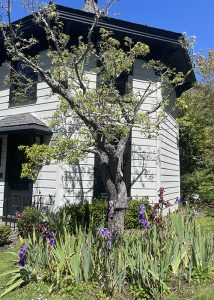
If you’re a regular visitor to Marin Art and Garden Center accustomed to entering through the arbor near the main office, you’ve had to reroute your path from the parking lot since we re-established the historic entry at the bridge across Kittle Creek. Now the arbor is a focus point of a different kind, with a set of large pots that feature some dramatic new plants.


and Board of Trustees member Jessica Fairchild work out the best placement for our new planters.
Gardening in containers is an elegant solution for spaces where in-ground planting isn’t possible. Even if you don’t have much room, you can take advantage of any space with a bit of sunshine to add the color and texture that only plants can bring. It’s worth doing a little planning to make sure your plants are a good match for the conditions so they can thrive. Garden Manager Steven Schwager advises spending some time looking at the location where you’ll put your planters to see how much sun they get at different times of day. Once your pot is filled with soil, it may be too heavy to move easily; you can look for planter caddies, which raise the pot up on casters so you can roll it if necessary. We were very fortunate to receive a generous discount on our planters, from Ore designs, in two different heights.
Another advantage of container gardening is that you control the quality of the soil. While all-purpose potting soil is fine for most projects, certain plants such as cacti and succulents prefer a sandier mix that drains quickly, and blueberries and azaleas like a more acidic environment to be their best selves. It’s important to ensure that whatever container you use for your plants, it should allow for drainage out the bottom. While containers do dry out faster than in-ground planted beds, you want to be sure water doesn’t collect at the base of the pot, which can cause roots to rot.
The fun part is choosing the plants. Steven suggests thinking in terms of contrasts: in height, leaf texture, and flower color. As long as the plants all tolerate the same growing conditions, you can mix and match as you please. You might decide to place a larger perennial plant in a container and fill in around it with annuals that you replace seasonally to refresh the look.
Steven selected plants that would present contrast and complement the planters. Since the area where they are situated gets a lot of direct sun and will require hand watering, he chose varieties that have good drought tolerance. These plants happen to be Australian natives, two varieties of leucodendron, “Gold Strike” and “Safari Sunset.” These plants are also known as conebushes, and you can see the cones forming at the end of the branches already. There are also two varieties of cordylines, “Electric Flash” and “Electric Pink.” These plants all have colorful foliage year-round, and will be a bright spot in the parking lot for visitors.
We hope you’ll take inspiration from these new planters to find a place for a container garden of your own. Remember, you can write to gardentips@maringarden.org with questions, we’re happy to help you manage your thorniest plant problems.




